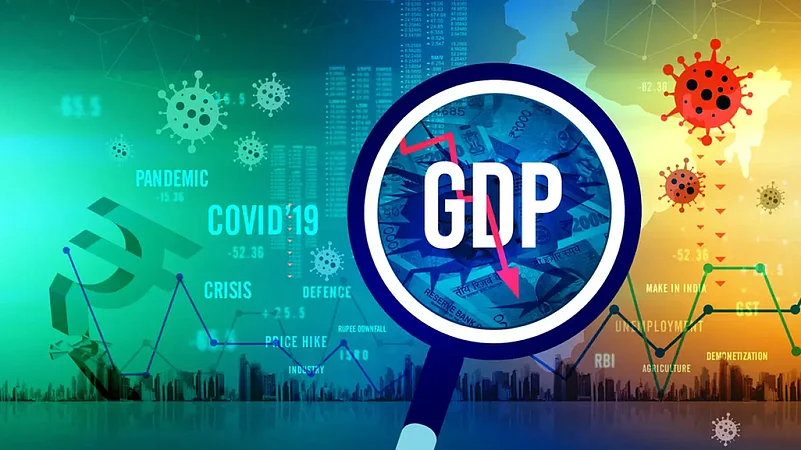India’s inflation-plagued economy received a further jolt when financial services company Nomura recently lowered its 2023 gross domestic product (GDP) growth projection for the country to 4.7 per cent from 5.4 per cent.
“While near-term growth momentum seems to be robust, we see rising medium-term growth headwinds from higher inflation, monetary policy tightening, dormant private Capex growth and, most importantly, the global growth slowdown. Consequently, we expect GDP growth of 7.2 per cent y-o-y (year on year) in 2022, but have lowered our 2023 GDP growth projection from 5.4 per cent to 4.7 per cent,” it said in a research note.
Advertisement
Nomura also said that despite the cut in fuel duties, there were broad-based inflationary pressures across most core categories. At 7 per cent y-o-y, June’s consumer price index (CPI) inflation was unchanged from May with food and beverages price inflation moderating but fuel and core CPI inflation inched higher—the latter rising to 6 per cent y-o-y from 5.9 per cent in May.
Nomura, however, is not the first global agency to downgrade India’s projection this year which comes as a cause for concern.
Downward Spiral
In its April monetary policy, India’s own central bank, the Reserve Bank of India, revised the country’s growth projection downwards for the current fiscal (FY23) to 7.2 per cent from its earlier estimate of 7.8 per cent.
Advertisement
Globally, in June, the World Bank brought down India's economic growth forecast for the current fiscal to 7.5 per cent from 8 per cent. Interestingly, this was its second revision. In April, it had trimmed the forecast from 8.7 per cent to 8 per cent.
“In India, growth is forecast to edge down to 7.5 percent in the fiscal year 2022-23, with headwinds from rising inflation, supply chain disruptions, and geopolitical tensions offsetting buoyancy in the recovery of services consumption from the pandemic,” the World Bank said in its Global Economic Prospects June 2022 report.
It further stated that growth will be supported by fixed investment undertaken by the private sector and by the government, which has introduced incentives and reforms to improve the business climate. “Growth is expected to slow further to 7.1 percent in 2023/24 back towards its longer-run potential,” it added.
Just like Nomura and World Bank, agencies and organizations like Moody’s Investor Service, International Monetary Fund (IMF), Organisation for Economic Cooperation and Development (OECD), Fitch Ratings and S&P Global Ratings have all lowered their GDP growth forecast for India.
While Moody’s has brought it down to 8.8 per cent for the calendar year 2022 (CY22) from its March estimate of 9.1 per cent, IMF has projected that India would grow by 8.2 per cent in 2022-23, a sharp downward revision from its earlier projection of 9 per cent.
The OECD has revised India’s FY23 economic growth projection to 6.9 per cent from the earlier projected 8.1 per cent, Fitch has slashed it to 8.5 per cent from 10.3 per cent and S&P Global Ratings has trimmed it to 7.3 per cent from 7.8 per cent earlier.
Advertisement
Why Is India Getting Downgraded?
To begin with, the Covid-19 outbreak, ensuing lockdowns and restrictions battered the economic activity in India gravely.
Just as it was limping out of the economic fallout back to normalcy, the Russia-Ukraine war dealt a severe blow to the global supply chains. The war skyrocketed prices of everything—from essential food products to fuel. Soaring global inflation forced most central banks to hike lending rates in a bid to control inflation.
India’s inflation, too, has become chronic. At 7.01 per cent, June’s CPI inflation remained above the RBI's tolerance band of 2-6 per cent for the sixth month in a row. To tame inflation, the RBI opted for a hike in the interest rate by 90 bps to 4.9 per cent in two policy meetings. It also revised its inflation forecast for FY23, ending March 2023, to 6.7 per cent from 5.7 per cent.
Advertisement
Experts believe that food prices, which account for nearly half of the inflation basket, are expected to remain high due to supply chain issues and crude oil price increases amid geopolitical tensions. Concern regarding India’s inflation seems to be a major culprit behind rating agencies downgrading India’s GDP forecast.
While the Indian economy is gradually gaining momentum as far as demand and consumption are concerned, the overall price level rise, especially for input costs, has proven to be the biggest challenge to the country’s ongoing recovery.















 Just one email a week
Just one email a week